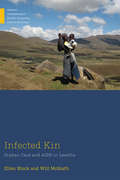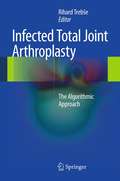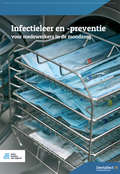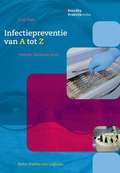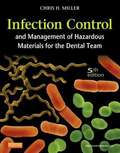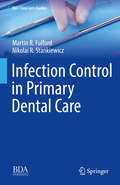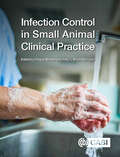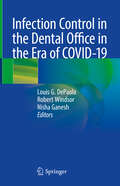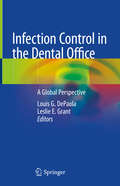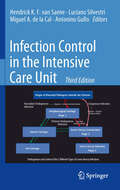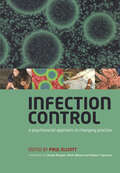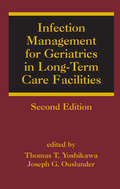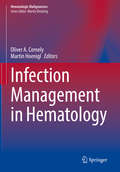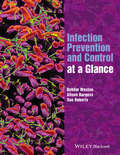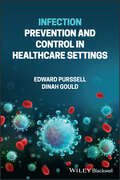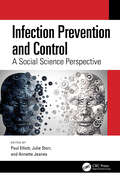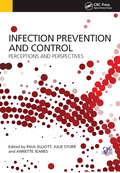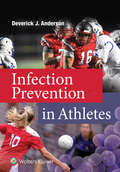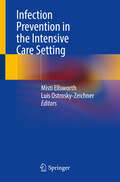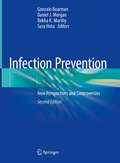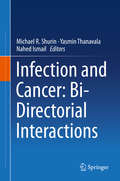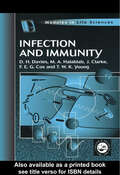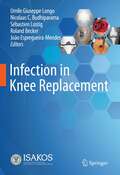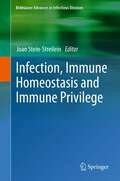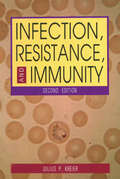- Table View
- List View
Infected Kin: Orphan Care and AIDS in Lesotho (Medical Anthropology)
by Ellen Block Will McGrathAIDS has devastated communities across southern Africa. In Lesotho, where a quarter of adults are infected, the wide-ranging implications of the disease have been felt in every family, disrupting key aspects of social life. In Infected Kin, Ellen Block and Will McGrath argue that AIDS is fundamentally a kinship disease, examining the ways it transcends infected individuals and seeps into kin relations and networks of care. While much AIDS scholarship has turned away from the difficult daily realities of those affected by the disease, Infected Kin uses both ethnographic scholarship and creative nonfiction to bring to life the joys and struggles of the Basotho people at the heart of the AIDS pandemic. The result is a book accessible to wide readership, yet built upon scholarship and theoretical contributions that ensure Infected Kin will remain relevant to anyone interested in anthropology, kinship, global health, and care. Supplementary teaching materials are available at: https://www.csbsju.edu/sociology/anthropology-teaching-resources/useful-resources/infected-kin-teaching-resources
Infected Total Joint Arthroplasty
by Rihard TrebšeThere are a variety of protocols that are used in infected total joint arthroplasty. This book outlines and details the best possible course of treatment and formulate custom algorithms for every possible case, based on current evidence. It reviews current concepts and "recipes" for the diagnostic and therapeutic procedures (surgical and antibiotic) based on the type of implant, infection and the patient. This book is an essential resource on infected total joint arthroplasty, containing a series of logical and highly detailed instructions that will serve to educate orthopedic surgeons operating in this field on the best approaches, according to detailed and careful research conducted over the last decade.
Infectieleer en -preventie: Voor medewerkers in de mondzorg
by D.M. VoetInfectieleer en -preventie is geschikt voor medewerkers in de mondzorg die met patiëntenzorg of instrumentarium in aanraking komen. Het geeft op heldere en praktijkgerichte wijze inzicht in de thema's die belangrijk zijn in het voorkomen van infecties. Dit boek is geschreven voor (toekomstige) tandartsassistenten, maar is ook zeer geschikt als leerboek of naslagwerk op het gebied van gezonde praktijkvorming voor alle andere medewerkers in de mondzorg.
Infectiepreventie van A tot Z
by D. M. VoetPraktijkgerichte vakinforamtie voor de moderne tandartsassistent. De reeks is te gebruiken voor scholing, het opfrissen van kennis en als naslagwerk.
Infection Control and Management of Hazardous Materials for the Dental Team (Fifth Edition)
by Chris H. Miller Charles John PalenikEmphasizing patient safety and infection prevention in the dental office, Infection Control and Management of Hazardous Materials for the Dental Team, 5th Edition, covers everything from basic concepts in microbiology to protocols for clinical asepsis. Clear, step-by-step instructions make it easy for you to perform safety procedures and use the supplies and equipment needed to prevent the spread of infectious disease. New to this edition are full-color photographs and four new chapters on emerging topics. Written by oral biology and infection control expert Chris Miller, this resource is a must read for every member of the dental team. Comprehensive coverage follows dental assisting and dental hygiene curricula requirements for infection control, ensuring that you learn essential principles and procedures for clinical competence. Easy-to-follow, step-by-step procedures are provided for skills that dental team members must master, each presented with a goal, materials, chronological steps, and rationales for the performance of each step. Key terms begin each chapter and are highlighted within text discussions and defined in a back-of-book glossary. Summary tables and boxes make study easier by highlighting key concepts and procedures. Review questions ensure your comprehension of the material with 5 to 20 multiple-choice questions at the end of each chapter. Practical appendices offer easy access to the most significant regulatory agency rules and recommendations for infection control. Student resources on the Evolve companion website include practice exercises plus review questions and quizzes. NEW! Full-color photographs show the latest equipment, supplies, and procedures and accurately depict concepts in microbiology and the nature of infectious disease. Four NEW chapters cover changing and emerging topics and trends in infection control, including Hand Hygiene, Preventing Sharps Injuries, General Office Asepsis, and Cross-contamination Between Work and Home. NEW! Case scenarios on the Evolve companion website examine an infection control incident along with its potential consequences, possible preventive measures, and related recommendations and regulations. UPDATED content includes new areas such as technology involving surface and equipment asepsis, dental water unit air quality, and green infection control.
Infection Control in Primary Dental Care (BDJ Clinician’s Guides)
by Martin R. Fulford Nikolai R. StankiewiczThis book is an easy-to-use guide to all aspects of infection control and decontamination that will support the implementation of effective measures for risk reduction in dental practice. Among the topics addressed are the principles and practicalities of cleaning and sterilizing dental instruments, the role of personal protective equipment, the design and use of decontamination rooms, choice of dental equipment, environmental disinfection, and considerations relating to dental unit water lines. In addition, readers will find an informative and helpful section on the background history and basic science of infection control within dentistry. Infection Control in Primary Dental Care will be very useful for all members of the dental team, including dentists, dental nurses or assistants, dental hygienists, and therapists. The book is illustrated with photographs, diagrams, and tables to aid understanding and encourage good practice. The authors have a background in microbiology and dental practice and have extensive experience of providing advice and guidance to professional colleagues on infection control procedures.
Infection Control in Small Animal Clinical Practice
by Shabbir Simjee Tom Reilly Tim Nuttall Alison Young Lindsey Ashburner Craig R. Breheny Jocelyn Bisson Caitlin Forbes Sian-Marie Frosini Andrew Gardiner Owen Glenn Rosanne Jepson Brandy A. Burgess Rungtip Chuanchuen Martyna Godniak Emily Gorman Eleanor Haskey Thawanrut Kiatyingangsulee Steven Murphy Lucas Pantaleon Kathryn Pratschke Alan D. Radford Mellora Sharman Helen Silver-MacMahon David A. Singleton Katie Smyth Faye Swinbourne Denis Verwilghen Martin L. Whitehead Nicola J. WilliamsInfection prevention and control is vital within a veterinary setting, but can find itself an automated part of care - and therefore vulnerable to time constraints, forgetfulness and routine. This book is written by experts in the field and uses evidence-based findings to elevate infection prevention to a well understood, dynamic concept, relevant to both veterinary practitioners and nurses in practice. Comparing key findings to the human healthcare world, this book: Maximises learning opportunities with lots of practical examples and cases; Provides practical how-to sections, such as setting up a surveillance programme; and Bases findings on current veterinary literature. Beginning with an introduction to the importance of infection control, dedicated chapters in this book then consider key principles such as hand hygiene, personal protective equipment, infection control for the surgical and hospitalised patient, and care for immunosuppressed individuals. Importantly, this book presents an up-to-date exploration of responsible antibiotic use in the context of rising resistance.
Infection Control in the Dental Office in the Era of COVID-19
by Robert Windsor Louis G. DePaola Nisha GaneshThis book discusses the treatment of dental patients in the post-COVID pandemic years and the required compliance with recommended infection control practices to ensure the safe delivery of oral health care.The COVID-19 pandemic has had the most dramatic impact on healthcare, inclusive of dentistry, in history. SARS-CoV-2, the virus that causes COVID-19, is a very dynamic virus and each new variant appears to be more transmissible than previous variants. More effective infection control strategies had to be developed to prevent transmission of COVID-19 in the dental office.Readers will find guidance on the reduction of aerosol in the dental office, information on vaccines, vaccinations and the re-emergence of vaccine preventable diseases. Infection control during implant placement, oral surgical procedures, N2O administration and IV sedation is explained. In addition to SARS-CoV-2, the book provides information on other emerging respiratory diseases such as Influenza,Respiratory Syncytial Virus (RSV) and the emergence of Vaccine Preventable Diseases (Measles, Mumps, Rubella, Polio, HPV) that present significant risk of transmission if proper infection control practices are not followed. The indirect effects of the COVID-19 pandemic are discussed including a significant increase of STDs (syphilis, gonorrhea, chlamydia, herpes, HPV), new blood- borne infections such as HIV, HBV and HCV infections, as well as a significant increase of healthcare acquired infections and superbugs.
Infection Control in the Dental Office: A Global Perspective
by Louis G. DePaola Leslie E. GrantThis book reviews the principles of infection control and the guidelines and standards of care in multiple countries, discussing them within the context of the practice of dentistry. The aim is to enable dental practitioners to ensure that the appropriate measures are adopted for each patient contact, thereby minimizing the risk of transmission of infection – a goal that is becoming ever more important given the threats posed by new or re-emerging infectious diseases and drug-resistant infections. Readers will find information and guidance on all aspects of infection control within the dental office: hand and respiratory hygiene, use of personal protective equipment, safe handling of sharps and safe injection practices, management of occupational exposures, maintenance of dental unit water quality, surface disinfection, and the cleaning and sterilization of dental instruments. Infection Control in the Dental Office will be an invaluable asset for all dental practitioners, including dentists, dental specialists, dental hygienists, and dental assistants.
Infection Control in the Intensive Care Unit
by Antonino Gullo Luciano Silvestri Miguel A. Cal Hendrick K.F. SaeneIntensive care is a rapidly changing area of medicine, and after four years from the 2nd edition the volume editors and authors have deemed necessary to update it. In the recent years, in fact, five new randomised controlled trials and five new meta-analyses demonstrate that selective decontamination of the digestive tract [SDD] is an antimicrobial prophylaxis to prevent severe infections of not only lower airways but also of blood. Additionally, SDD has been shown to reduce inflammation including multiple organ failure and mortality. An intriguing observation is the evidence that SDD using parenteral and enteral antimicrobials reduces rather than increases antimicrobial resistance. Moreover, a new chapter on microcirculation had been added. The volume will be an invaluable tool for all those requiring in depth knowledge in the ever expanding field of infection control.
Infection Control: A Psychosocial Approach to Changing Practice
by Paul Elliott Sheila Morgan Professor Mark Wilcox Dr Robert C SpencerPaul Elliott has drawn together a thought-provoking collection of topics that together explain the psychology of infection prevention and control. This is a book about how to change and improve practice, written by people who understand the trade of infection prevention and control. Reflection exercises are cleverly used throughout the text to provoke the reader to think of their own experiences in and their practice of healthcare. The reader is led into considering how improvements can be made to the delivery of infection prevention and control, and at the same time to understand why the way we think ultimately determines the likelihood of their success. Each reflection exercise is accompanied by clear and concise explanations, helping the reader to analyse and critique him/ herself and the way we do things now.
Infection Management for Geriatrics in Long-Term Care Facilities (Infectious Disease and Therapy)
by Thomas T. Yoshikawa Joseph G. OuslanderOffering an authoritative overview of all infection management protocols currently utilized by infectious disease specialists, geriatricians, and infection control practitioners, this Second Edition examines current strategies to diagnose, treat, control, and prevent common infectious diseases in long-term care geriatric facilities. Covering a wide
Infection Management in Hematology (Hematologic Malignancies)
by Oliver A. Cornely Martin HoeniglThis book provides a thorough update on the management of infections in patients with hematologic malignancies, focusing particularly on prevention, diagnosis, and treatment. Detailed attention is devoted to the central roles that vaccination and anti-infective prophylaxis have gained in improving overall survival in this patient group, in accordance with the principle that prevention is better than cure. Careful consideration is also paid to risk stratification, which is crucial in ensuring that anti-infective prophylaxis is targeted to those at the highest risk. While preventive strategies reduce the prevalence of infections, optimized management strategies are vital to decrease infection-related morbidity and mortality in those who nevertheless develop infections. Here, readers will find in-depth, up-to-date knowledge on the diagnosis and treatment of bacterial, fungal, viral, and parasitic infections, according to the affected organ and the causative pathogen. Finally, treatment in intensive care units is reviewed. The book will be of high value for hematologists, oncologists, and infection specialists.
Infection Prevention and Control at a Glance
by Debbie Weston Sue Roberts Alison BurgessInfection Prevention and Control at a Glance isthe perfect companion for study and revision for pre-registration nursing and healthcare students, as well as qualified nurses and medical students. Infection prevention and control is one of the key five 'essential skills clusters' that is incorporated into all pre-registration nursing programmes. This highly visual and dynamic book is a thorough resource for nurses wanting to consolidate and expand their knowledge of this important part of nursing. Written by experienced infection prevention and control specialist nurses, it provides a concise and simple approach to a vast and complex subject, and equips the reader with key information in relation to various aspects of infection prevention and control practice. Provides a snap-shot of the application of infection prevention and control in practice and the key infections affecting patients in both acute and primary care A uniquely visual and accessible overview of a topic of relevance to all nursing staff Includes key points for clinical practice, patient management, and signposting of key national guidance documents and websites Available in a wide-range of digital formats - perfect for 'on the go' study and revision
Infection Prevention and Control in Healthcare Settings
by Dinah Gould Edward PurssellINFECTION PREVENTION AND CONTROL IN HEALTHCARE SETTINGS In Infection Prevention and Control in Healthcare Settings, a team of distinguished researchers deliver an accessible and authoritative introduction to infection control and prevention in hospital and community settings. This is a key resource as professionals deal with the ongoing impact of the COVID-19 pandemic, and require the latest and most up-to-date information. Central topics are discussed at the individual and population levels, with direct links to lessons learned throughout the COVID-19 pandemic. The book is written from an evidence-based perspective that utilises modern approaches, reflecting current decision-making methods like GRADE and WHO Evidence to Decision Frameworks. Readers will also find: A thorough introduction to the chain of infection and the main groups of micro-organisms causing infection Comprehensive explorations of the application of evidence-based practice principles to infection prevention and control Practical discussions of immunity, microbiology laboratories, antimicrobial drugs, and policies and protocols for infection prevention and control The role of epidemiology and public health in the prevention and control of infectious disease Perfect for student nurses and students of allied health professions, Infection Prevention and Control in Healthcare Settings will also benefit practitioners and managers in the health services seeking to update their knowledge of infection control and prevention in healthcare settings.
Infection Prevention and Control: A Social Science Perspective
by Paul Elliott Julie Storr Annette JeanesAn understanding of the social sciences within infection prevention and control (IPC) is important for those working in health and social care. This new book, Infection Prevention and Control: A Social Science Perspective positions the specialty of IPC as more than a technical discipline concerned with microbes. It is about people and their behaviour in context and the book therefore explores a number of relevant social sciences and their relationship to IPC across different contexts and cultures. IPC is relevant to every person who works in, and accesses health care and it remains a global challenge. Exploring novel approaches and perspectives that expand our collective horizons in an ever changing and evolving IPC landscape therefore makes sense. Key Features: Offers new perspectives beyond the topic area of infection prevention and control, to push the frontiers of knowledge and to challenge the status quo. Interprofessional in nature and relevant to all those involved in the provision of medicine, health, and social care irrespective of their roles. Truly international in nature in that the chapters have been developed by a range of individuals from across the globe.
Infection Prevention and Control: Perceptions and Perspectives
by Paul Elliott Julie Storr Annette JeanesThis book presents a variety of perceptions of and perspectives on infection prevention and control. In doing this, the chapters will reflect upon challenging and controversial new ways of looking at infection prevention and control aimed at generating both discussion and debate as well as practical solutions. With this in mind, the book will aim not only to challenge the existing status quo but also push the frontiers of knowledge, thinking and practice where infection prevention and control is concerned. This is vital when considered in the light of cross infection rates, the number of healthcare providers who are being identified by the Care Quality Commission as falling below acceptable standards of infection prevention and control and the almost compulsive persistent non-adherent behaviours of those involved in the provision of medicine, health, social care and other disciplines related to caring with regards to the undertaking of safe and appropriate standards of infection prevention and control. There is no doubt that this book will be challenging with regards to the readers' perceptions and perspectives of infection prevention and control. Where this topic is concerned however, such a challenging approach is vital if the health, safety and well being of individuals is to be positively promoted among all those involved in the health and wellbeing of others.
Infection Prevention in Athletes
by Deverick AndersonDerived from protocols developed for the National Football League, Infection Prevention in Athletes outlines best practices and recommendations that are designed to minimize the risk of infections among athletes. This unique resource provides concise, authoritative guidance for athletic training facilities on applying infection prevention practices typically provided in hospitals and outpatient clinics. You’ll find practical tips and real world advice on preventing transmission of bacterial and viral infections in an environment of frequent skin injuries, close proximity of players, and frequent administration of routine medical care.
Infection Prevention in the Intensive Care Setting
by Misti Ellsworth Luis Ostrosky-ZeichnerThe National Healthcare Safety Network (NHSN) system reports that approximately 1 in every 31 hospitalized patients develop at least one hospital acquired infection (HAI). Deaths associated with these infections are estimated to be up to 99,000 per year. In 2015 alone, there was an estimated 687,000 HAIs linked to the acute care hospital setting. According to the WHO, in high income countries 30% of these infections occur in the Intensive Care Unit (ICU). Patients in the ICU often have multiple risk factors that increase the risk of developing a HAI. These risk factors include the need for indwelling catheters and other medical devices, patient related factors such as underlying comorbidities, immunosuppression, and the need for recurrent hospitalizations. Nosocomial infections lead to significant morbidity and mortality. Patients who develop infections in the ICU have double the mortality and morbidity when compared to noninfected patients. In addition to the increased morbidity and mortality, cost of care and length of stay is also significantly higher. Despite widespread adoption of infection prevention practices in the ICU setting, preventable infections still occur daily in ICUs across the country. This book provides a comprehensive review of infection prevention in the ICU setting including new and cutting-edge techniques to prevent HAIs. This book serves as a reference text for physicians, nurses, and quality leadership working in the ICU setting. It discusses the most recent definitions from NHSN for CLABSIs, CAUTIs, and SSIs as well as the current recommendations for preventing device and surgery associated nosocomial infections. In addition, there are chapters on other basic infection prevention practices such as how to identify unit HAI outbreaks. Finally, it addresses unique aspects of infection prevention in special populations such as neonates, pediatric patients and immunocompromised hosts, as well as explore unique infections risks in trauma, surgical and burn units. Written by experts in the field, Infection Prevention in the Intensive Care Setting is a valuable resource for intensive care physicians, infectious disease physicians, intensive care nurses, infection prevention practitioners, pulmonary specialists, residents in internal medicine and pediatrics as well as pediatric and adult infectious disease fellows.
Infection Prevention: New Perspectives and Controversies
by Gonzalo Bearman Daniel J. Morgan Rekha K. Murthy Susy HotaThe first edition of Infection Prevention reviewed evolving areas in infection prevention on topics including contact precautions, technology implementation, specific infections, and care in various settings. It summarized the current data on infection prevention, presents controversies on the various topics, and includes recommendations for patient safety. Addressing hot topics such as MRSA, C. difficile vaccination, mandatory flu vaccines, and CLABSI, this is the only text to include prevention and control overviews across a range of infection issues. Written by experts in the field, this successor edition will update current chapters on the most cutting-edge models of care on emerging and evolving topics in infectious diseases. It will also include new material and chapters on high-level disinfection, diagnostic test stewardship, unique pathogens units, outpatient antibiotic stewardship, outpatient antibiotic therapy, as well as a chapter on infection prevention metrics: how much can we prevent healthcare associated infections and how hard should we try. The second edition of Infection Prevention: New Perspectives and Controversies is a valuable resource for infection prevention professionals, healthcare quality and safety professionals, caring for patients in in- and outpatient settings.
Infection and Cancer: Bi-Directorial Interactions
by Michael R. Shurin Yasmin Thanavala Nahed IsmailThis unique book summarizes current knowledge on co-development of infectious diseases and cancer. It provides an overview of the complex and unique role of the immune system, inflammation, tumor-mediated immunosuppression and infection-induced immunomodulation in cancer and infection progression. Chapters are organized into themed parts, beginning with a look at the historical perspective of human tumor viruses, then aspects and examples of infection-related cancers and cancer-associated infections. The work discusses how cancer- and infection-associated immune responses interact in a bi-directorial fashion and how these interactions may evolve during both disease progression and in response to therapy. The phenomenon of independent development of cancer and infection in the same host, known as comorbid cancer-infection progression, is explored. Understanding the complex pathways involved in the progression of infection and cancer will allow the prevention of the development of certain types of cancer, as well as advancing prophylactic anti-cancer vaccines. Readers of this work will discover innovative approaches for multidisciplinary projects, focusing on the design of original therapeutic modalities for cancer therapy. The book will therefore be particularly valuable to scholars interested in cancer immunology and researchers and clinicians in the field of basic and applied immunobiology and microbiology.
Infection and Immunity (Lifelines Series)
by D H Davies M A Halablab T W Young F. E. Cox J. ClarkeThis concise text explores the interactions between pathogens and the immune system. Taking a disease-based approach, it explains how micro-organisms adapted to growth in human hosts can evade the immune system and cause disease.The opening chapter overviews the innate and adaptive immune responses to microbes. Subsequent chapters are specific
Infection in Knee Replacement
by Roland Becker João Espregueira-Mendes Sébastien Lustig Umile Giuseppe Longo Nicolaas C. BudhiparamaThis book provides an in-depth overview of the aetiology, treatment and prevention of infections following knee arthroplasty. It presents up-to-date information on available techniques and salvage procedures for complex patients with infected, total knee arthroplasty.Divided into 5 sections, this book explores biomaterials, clinical manifestations, diagnosis, treatment and prevention, including preoperative optimisation, in order to reduce knee infections. This book is a valuable reference resource for practicing orthopaedic surgeons, residents, and medical students wishing to understand the fundamental concepts in infectious disease medicine needed in current orthopaedic practice.
Infection, Immune Homeostasis and Immune Privilege
by Joan Stein-StreileinOrgans and tissues that can tolerate little or no inflammation have developed multiple overlapping mechanisms of immune protection in the absence of inflammation. These areas have been designated "immune-privileged sites" by Peter Medawar and include the central nervous system, eye, reproductive tract, testis and possibly the liver. Mechanisms of immune homeostasis found in less immune-regulated organs are often evident in the immune privileged sites and vice versa. It is important that the non-inflammatory mechanisms that contribute to immune privilege allow host defense against infectious organisms. This volume highlights the mechanisms leading to immune privilege in tissues and organs, the deviation of immune responses and the modification of the behavior of the immune cells that manage to cross the blood barriers of tissues, in the context of infection.
Infection, Resistance, and Immunity, Second Edition
by Julius KreierDesigned as an introductory textbook, Infection, Resistance and Immunity provides basic information on the workings of the immunological system and on infectious processes and their control. With sections on immunological disorders, immunization, immunodiagnosis, and epidemiology, it relates immunology to practical problems in medicine. The book includes a section on comparative immunology, introducing students to differences among immunological systems among common species of nonhuman animals. Written for the advanced undergraduate, the focus is on host-parasite interactions—distinguishing this text from other standard texts, which focus on the cellular mechanisms of the immune response.
